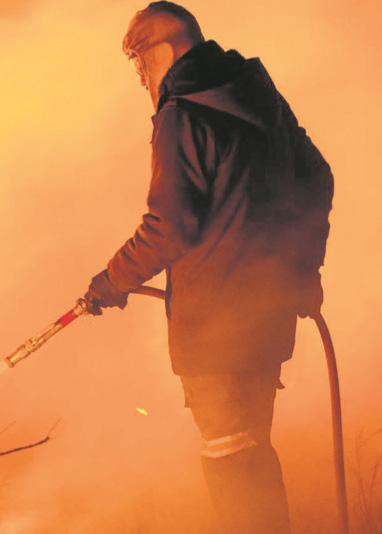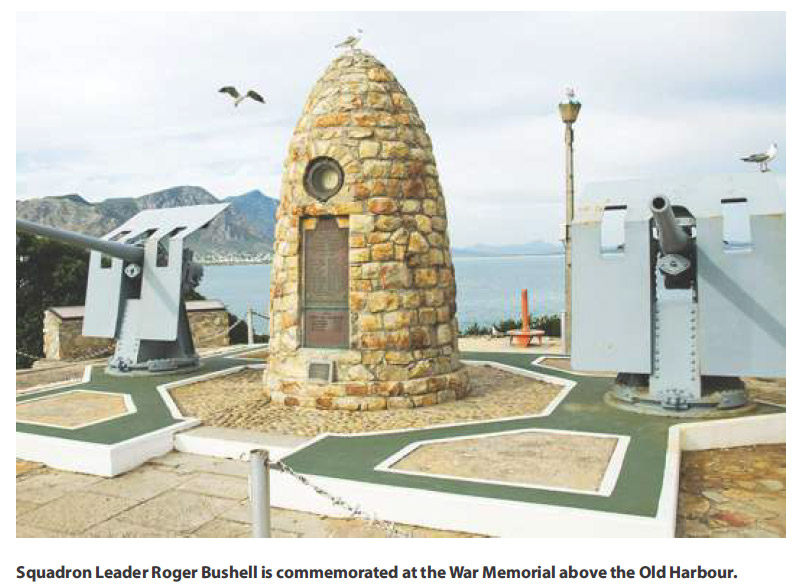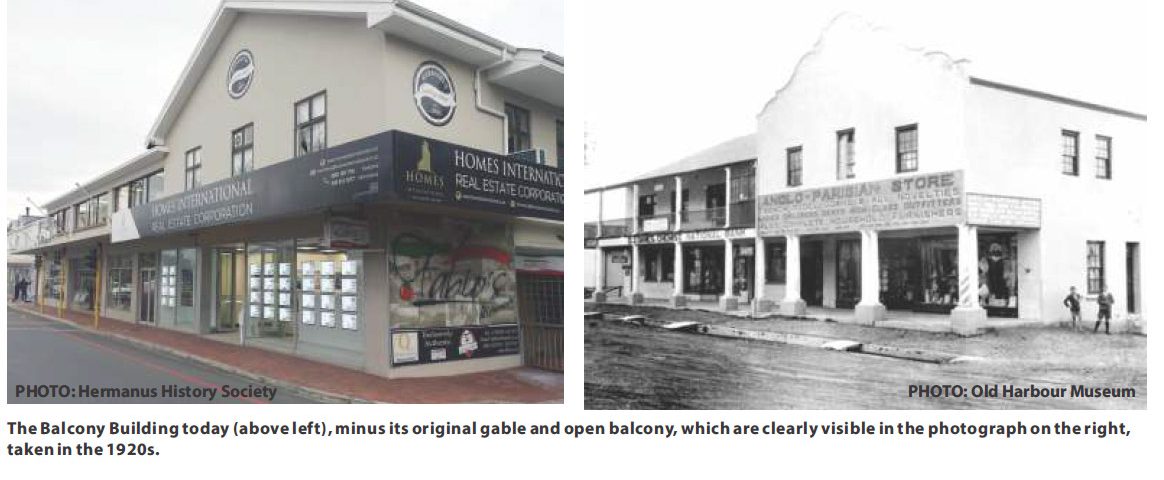
Reasons for fires
August 6, 2018
Hermanus’ links to The Great Escape
August 14, 2018The Balcony Building (numbers T58 – 62 Main Road) is today mainly associated with the Hermanus Factory Shop, which was opened in this building in 1983 by a Swiss national, Jörg Friedrich who managed the business for 30 years. The present owner, Fransien Koegelenberg took over in 2013 and has since expanded the business, which now occupies most of the building, both on the ground floor and first storey. At present a real estate corporation named Homes International is on the corner of Main Road and St. Peter’s Lane. Fabio’s Ristorante, which opened for business a decade ago, is around that corner and faces onto the Lane, but structurally it is part of the Balcony Building.
The Balcony Building was constructed in the early 1900s, perhaps as early as 1906. The work was done by Robert Walter MacFarlane (1874 – 1955), son of one of the original settlers, who was also named Walter MacFarlane. Many of the men in the family were named Walter, so Robert Walter was generally known as Wattie. He constructed the Ocean View Hotel at about the same time as the Balcony Building. Wattie served as Mayor of Hermanus from 1923 – 1926. The Balcony Building was almost certainly the largest commercial building in Hermanus at the time it was built, and was well-situated, at the junction of the two most important streets in Hermanus, and adjacent to the Anglican Church. It was also diagonally opposite the Victoria Hotel which belonged to Walter MacFarlane, Senior.
named Walter MacFarlane. Many of the men in the family were named Walter, so Robert Walter was generally known as Wattie. He constructed the Ocean View Hotel at about the same time as the Balcony Building. Wattie served as Mayor of Hermanus from 1923 – 1926. The Balcony Building was almost certainly the largest commercial building in Hermanus at the time it was built, and was well-situated, at the junction of the two most important streets in Hermanus, and adjacent to the Anglican Church. It was also diagonally opposite the Victoria Hotel which belonged to Walter MacFarlane, Senior.
There are no records of ownership and tenants until the 1920s. By that time, the most notable feature of the building was a roller-skating rink. I assumed that this could only have been on the ground floor, as the weight of dozens of skaters and the noise created would have been dangerous and disturbing for any business beneath it.
However, there is oral evidence that the rink was on the first floor. Peter van Dyk told the late historian S J du Toit that in the 1950s: We loved the Balcony Tearoom where we could sit on the balcony and see the street panorama below. This was the place where the young people congregated, chatting and listening to the juke box. On the right side in the big hall was a roller-skating rink, later converted into offices. This seems to suggest that the tearoom and rink were on the first floor. Peter van Dyk confirms the existence of the hall in the Balcony Building:
The Balcony was the main hall in the village. The BESL (British Empire Service League) held their annual Christmas function in the roller-skating hall. The Grobbelaar Hall was not yet built… Another regular user of the hall was the annual ‘wild flower show’. Longstanding Hermanus resident Nancy Okes recalls the event in the 1920s:
…the flower show was held in the great room above Sandy Grant’s chemist shop… three long sets of trestle tables, covered with starched white cloths stretched down the room. On these were vases and pots and bowls of fynbos… Onlookers spoke in hushed tones. The scent was overwhelming…
When in later years I read about the ‘upper room’ my mind always returned to the flower show
For nearly 60 years, Alex Grant Pharmacy occupied one shop on the ground floor, fronting on to Harbour Road. It now forms part of the Factory Shop. It was opened in the early 1920s as I Davies Pharmacy, the first pharmacy in Hermanus and a branch of the same business in Caledon. As there was no training institution for pharmacists in South Africa at that time, Mr Idris Davies, in need of an assistant, advertised through South Africa House in London. The opportunity caught the eye of a young man named Alexander Grant, a Scot from Aberdeen, but working at the time in London. Born in 1899, Sandy Grant (as he was always known) was only 15 when World War I broke out and lied about his age in order to join the war. He was trained as an ambulance man, carrying wounded soldiers from the battlefield. In 1917 he suffered severe consequences of mustard gas and had to spend an extended period in hospital. Keen to get away from these memories, he sailed for Cape Town aboard the RMS Windsor Castle in 1928. On the voyage he met Gertrude Hartington, who had taken up a teaching post in Grahamstown. As Sandy was going to Hermanus, their shipboard romance ended when they left Cape Town.
However, by one of those coincidences that seem to occur regularly in Hermanus, it so happened that teaching at Gertrude’s school in Grahamstown was a Miss Jean Luyt, daughter of P John Luyt, owner of the Riviera and Marine hotels. Gertrude came for the holidays to Hermanus, her romance with Sandy was reignited and soon after, they were married. Sandy worked for Mr Davies from 1928 until 1931, when he was able to acquire the business and change the name to Alex Grant Pharmacy. For the next 45 years the Grants developed the pharmacy into a profitable business and were a feature of every aspect of Hermanus life. Gertrude died in 1975 and Sandy continued to live in Hermanus in their art deco home ‘Hamewith’ until his death in 1988. He had sold the business in the 1980s and today it continues to serve the Hermanus public from the Gateway Centre.
The shops on either side of Alex Grant Pharmacy changed over time. An image from about 1925 shows three of these shops. On the right of the pharmacy as one faced it was a business called the Anglo-Parisian Store. It advertised itself as selling French model gowns and novelties. So far I have been unable to find out more details about it. Much later this area housed a branch of Foschini, and more recently of Total Sports, before they moved to the mall and Homes International took over the premises.
To the left of the pharmacy in the 1925 photograph you can make out the name of a branch of a bank which has the word “National” in its name. This was almost certainly a branch of the then largest bank in the country, the National Bank of South Africa Ltd. Established in the Eastern Province in 1838, this bank later merged with others to form Barclays Bank. Later still, it became FNB and now has much larger premises across the road from its original branch.
This branch of the National Bank, now taken over by the Factory Shop, was one of the businesses that left physical evidence of its operation – in this case, the walk-in safe. The door of the safe is still in fine working condition and revealed some interesting information. The manufacturer of the safe was a firm in London by the name of John Tann. The firm was the oldest safe makers in England, having been estab-lished by Edward Tann in 1790. They boast multiple awards and ‘by appointments’ and were considered the best safe makers in the world. Someone has written a date on the door: 1938.This was probably when the safe was installed. Obviously, no expense was spared by the bank, even in a small branch such as Hermanus.
There is no clear detail of all the other businesses in the Balcony Building over the decades. However, we do know that at one time the firm of Beunderman’s Electrical was next to Alex Grant Pharmacy, facing on to Main Road, and, on the other side, was a business belonging to the Nigrini family.
The owner was Malita (Bunny) Nigrini and correspondents describe it as a toy shop with a bicycle shop at the rear. Later, a women’s clothing shop known as Leonie’s operated from this spot. On the St Peter’s Lane side of the building there was a leather goods shop called Hakhak Leather, followed by two restaurants in succession (one was a Greek restaurant fondly remembered by many) before Fabio’s Ristorante opened 10 years ago.
Most of the rest of the first floor was partitioned into a fairly large number of offices. There are 13 original windows facing onto St. Peter’s Lane and it is reasonable to assume that each ventilated one office. There is clear evidence of a passage along this section so it is reasonable to assume that each office with a window was partnered with an office internal to the building, giving a maximum of 26 offices.
We know that a photographer had a studio in the building. He was Arthur Wilson. S J du Toit describes him as a favourite for portraits, family and wedding groups. He had to contend with formidable competition from T D Ravenscroft whose studio was a short distance away, in Main Road, where the post office boxes are now.
A dentist, Dr Seeliger had his rooms there as well. A long-standing Hermanus resident sent me this sketch of her experiences of visits to Dr Seeliger:
… I am sure (Dr Seeliger) was a very nice person, but we dreaded having our teeth drilled with that oldfashioned jackhammer. Neither I nor any of the locals in the village are likely to forget the sight of one of my cousins, who shall be nameless, being dragged, kicking and screaming up that flight of stairs at the very thought of having a filling.
The owner of the Hermanus Factory Shop, Fransien Koegelenberg has worked in the building since 1992
and learned many of its ins-and-outs from the originator of the shop. She has never had sight of formal plans, so the idea of how the building was laid out originally has to be deduced from renovations and changes in materials used. Two other businesses Fransien identified were Maddock’s (accounting) and her father-in-law’s business (J W Koegelenberg & Kie, also in accounting.)
The Sheriff of Hermanus in the latter part of the 20th century, Jannie McLachlan, also had his office in the building. There are three sash windows under the gable, which has itself unfortunately been removed. These windows probably provided ventilation for the Balcony Tea Room. Sandra Groenewald told S J du Toit in 2006 that, The Balcony was the favourite place for young people. They often danced there to tunes from the juke box. [I] remember the wide skirts and the colourful petticoats that had to be stiff, showing from under the skirts. In 1944, during World War II, Berdine Luyt from the Marine Hotel experienced another use for the Balcony Building:
We have had a strenuous time lately, chiefly raising money for War Funds. Gertrude Grant decided she wanted something “different” as a “do” in aid of St Dunstan’s, and after many discussions over gin and tonic on her sunny stoep, she decided on a one-night Night Club. She got the loan of the Balcony Hall from Mr Fourie, per-suaded Dulcie Howes to do a cabaret, and started organising. Gertrude ranks close to Mother when it comes to energy, but there is no one to touch her for charity – the real kind, the charity that is a loving compassion and is so beautifully described by St Paul.
The evening was a great success. Chairs and tables were packed round a small dance floor, the lights were dimmed and camouflaged and spot-lights rigged by the R.A.F. from the Bot River camp. The cabaret was the main attraction. Dulcie Howes very kindly brought some dancers down from her Cape Town studio, and they did a series of shows throughout the evening. The girls were wonderful and coped cheerfully with the small temporary dressing-room and restricted space. There were seats for 225 people, but many more crowded in, and grills were actually served to over 300, with Chef Hess [Head Chef at the Marine Hotel] in the kitchen.
The Hermanus Municipality occupied considerable space in the Balcony building from its inception in 1904 till the War years in the 1940s. Most Municipal business was conducted there. Then, for the duration of World War II, the Municipal Offices were removed to 9 Westcliff Road, to suit the Mayor Ms. Bebas Smuts. In 1951 the Municipality moved to its current offices.
In the 1970s the Jehovah’s Witnesses used the large room for services and gatherings. S J du Toit describes this period as follows:
…meetings were held in houses until the acquisition of the old recreational hall in the Balcony Building. The old place, covered in layers of dust was cleaned out with great zeal and turned into a pleasant place of worship…
When the stairs at the Balcony Building became too steep for some members, the congregation met at the Botanical Hall in Fernkloof…
The author would welcome inputs and/or photographs from readers in relation to the Balcony Building.
Please email them to robinlee@hermanus.co.za

